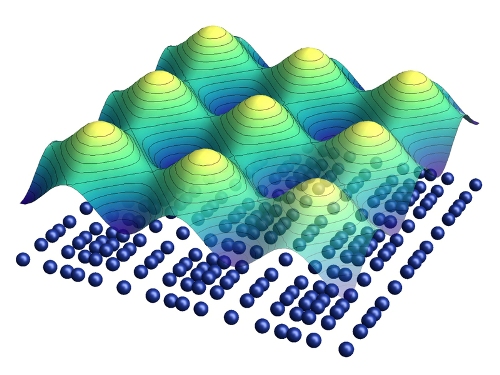An international research team, which includes scientists from the Max Planck Institute for Solid State Research, has found that there is a competition between high-temperature superconductivity and charge density waves.
 Researchers at the Max Planck Institute for Solid State Research have discovered charge density waves in ceramic yttrium and neodymium barium cuprates. They form above the temperature at which the material becomes superconducting and thus loses its electrical resistance, slightly distorting the crystal lattice, as indicated in a layer of the crystal lattice by the irregular distances between the atoms (blue spheres). The superconductivity competes with the charge density waves, and it is probably down to a coincidence that superconductivity prevails at a certain temperature. (credit: Daniel Pröpper/MPI for Solid State Research)
Researchers at the Max Planck Institute for Solid State Research have discovered charge density waves in ceramic yttrium and neodymium barium cuprates. They form above the temperature at which the material becomes superconducting and thus loses its electrical resistance, slightly distorting the crystal lattice, as indicated in a layer of the crystal lattice by the irregular distances between the atoms (blue spheres). The superconductivity competes with the charge density waves, and it is probably down to a coincidence that superconductivity prevails at a certain temperature. (credit: Daniel Pröpper/MPI for Solid State Research)
Previously, this competition was not considered by the researchers in their models, causing inaccuracy in their measurements of the transition temperature at which superconductivity begins. Further research provided insights into the interaction mechanism between superconducting materials and magnetic materials. The researchers discovered that the impact of the electronic properties on crystal vibrations was much higher than expected. This effect paves the way to manipulate material properties like superconductivity or thermoelectricity.
Bernhard Keimer and colleagues from the Max Planck Institute for Solid State Research strived to determine high-temperature superconductors both in terms of the standard description of temperature as well in practical terms. The international team included researchers from institutes, including the University of British Columbia, the European Synchrotron Radiation Facility Grenoble, the Politecnico di Milano and other research institutes.
One of their findings questions the existence of high-temperature superconductivity. They found that there is a competition between superconductivity in one kind of copper oxide ceramic and its charge density waves. In two-dimensional materials, the conduction electrons create a regular pattern of regions wherein they concentrate to a lesser or greater extent. However, in superconductors, the electrons rather than concentrating to a lesser or greater extent at regular intervals, they combine to create Cooper pairs that are able to traverse a crystal with zero resistance. Hence, the scientists were able to observe the charge patterns at a temperature only above the transition temperature.
The regions at which charge density waves appeared initially get extended when the scientists cooled down the material to the transition temperature. Nevertheless, at transition temperature, charge density waves vanished all of a sudden and superconductivity prevailed. Keimer informed that superconductivity would not exist at all if there was a slight difference in the distribution of the advantages.
The researchers observed the electronic competition by scanning yttrium and neodymium barium cuprates of the composition (Y,Nd)Ba2Cu3O6+x using resonant X-ray diffraction to observe the charge density waves. Now, the scientists in Bernhard Keimer’s team will conduct these calculations on other high-temperature superconductors to determine whether these materials electronically compete. Moreover, the Keimer’s team wants to reflect the difference between the two electronic states in its theoretical model of superconductivity.
In a different project, Keimer’s team studied the interaction mechanism between superconducting materials and magnetic materials by stacking a high-temperature superconductor with the formula YBa2Cu3O7 or YBCO and a magnetic material with the formula La2/3Ca1/3MnO3 or LCMO to create a few-nanometer-thick superlattice. The team especially studied the impact of the electronic processes on atomic vibrations – termed as electron-phonon coupling – by analyzing selected vibrations using a Raman spectrometer when the sandwich was cooled until superconductivity appeared in the YBCO and magnetic order in the LCMO. What surprised the team was the impact of superconductivity on vibration of the manganese oxide, said Keimer.
Although the Stuttgart-based scientists are not able to completely describe their findings, they have gained some insights into the mechanism of the long-range electron-phonon coupling. The long-range electron-phonon coupling in the LCMO-YBCO superlattice is not useful in driving up the transition temperature but provides insights into the interplay between superconducting and magnetic materials. This helps the Stuttgart-based scientists to develop superconductors capable of efficiently transporting electricity from solar parks and wind farms to consumers.